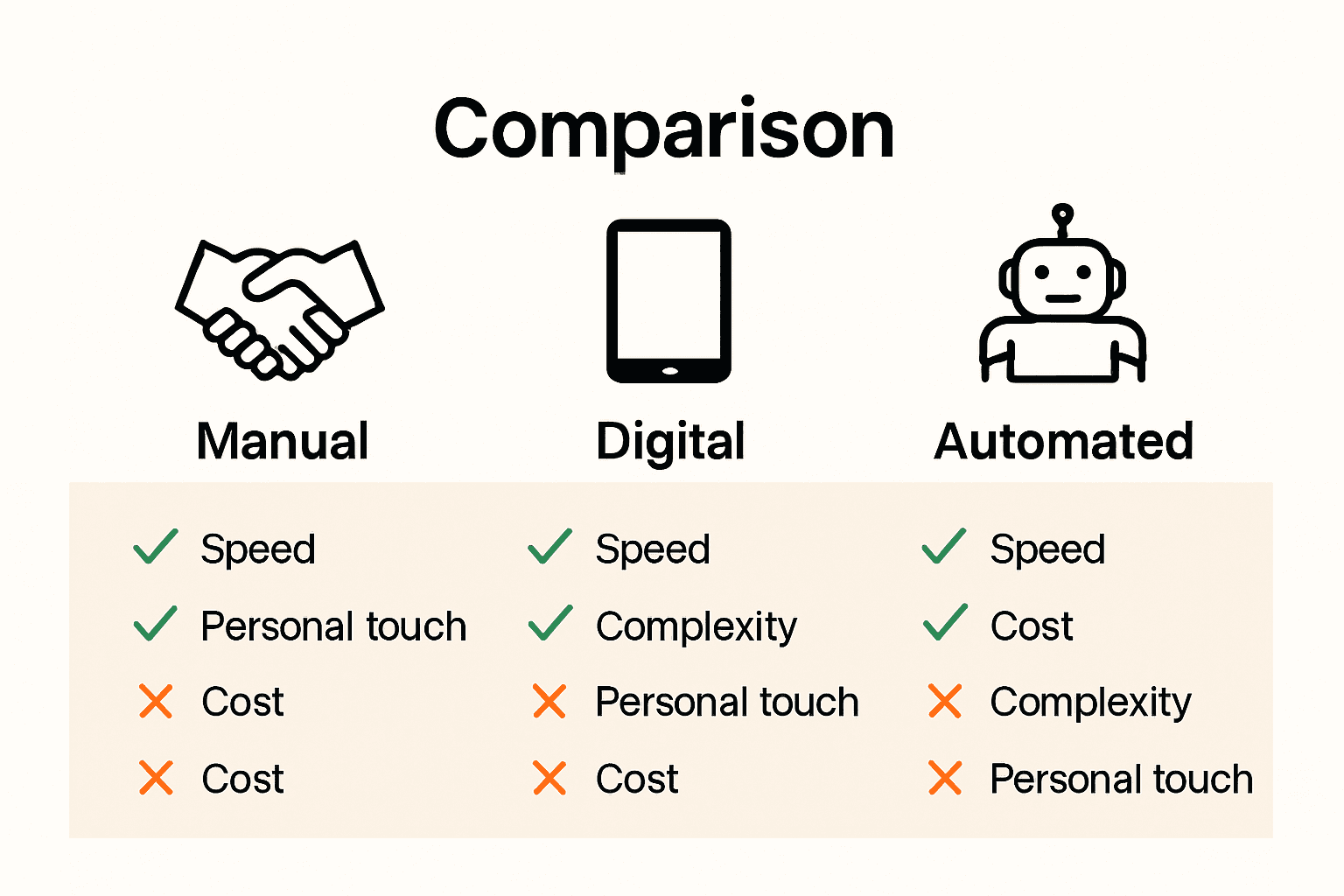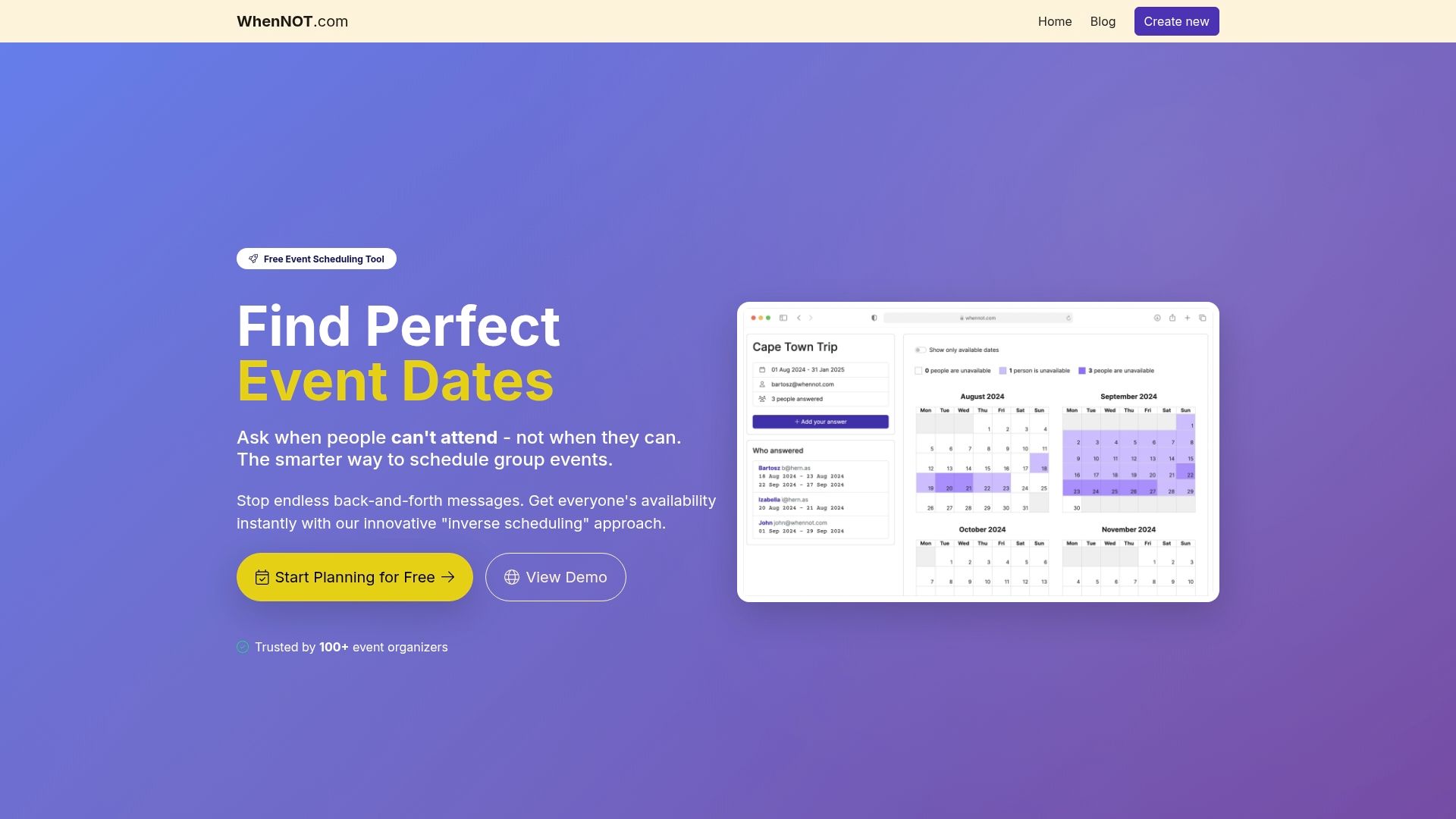Nearly 60 percent of professionals say scheduling conflicts are their biggest barrier to successful meetings and events. Finding the right time for a group is more than just comparing calendars. Whether for a business conference or a family get-together, smart event scheduling means balancing individual needs and logistical realities. Mastering these skills leads to smoother planning, fewer headaches, and events everyone can enjoy.
Key Takeaways
| Point | Details |
|---|---|
| Strategic Scheduling | Effective event scheduling involves coordinating participant availability, institutional constraints, and logistical details to ensure success. |
| Methods Overview | Manual, digital, and automated scheduling methods each have unique advantages; choosing the right strategy enhances efficiency. |

 |
| Common Pitfalls | Avoid miscommunication and misunderstandings by providing clear context, respecting time zones, and engaging participants in the scheduling process. |
| Inverse Scheduling | This innovative approach focuses on identifying when participants are unavailable, simplifying coordination for complex events. |
|
| Common Pitfalls | Avoid miscommunication and misunderstandings by providing clear context, respecting time zones, and engaging participants in the scheduling process. |
| Inverse Scheduling | This innovative approach focuses on identifying when participants are unavailable, simplifying coordination for complex events. |
Table of Contents
- Key Components Of Event Scheduling
- Event Scheduling Methods
- Manual Scheduling Methods
- Digital Scheduling Approaches
- Automated Scheduling Technologies
- Event Scheduling Terminology
- Inverse Scheduling
- Common Scheduling Pitfalls
Event scheduling is more than just picking a date. It's a strategic process of aligning multiple people's availability, institutional requirements, and logistical constraints to create a successful gathering.
According to Wikipedia's definition, event scheduling encompasses finding suitable times for various events like meetings, conferences, and trips while carefully avoiding scheduling conflicts. This process requires careful consideration of multiple factors: participant availability, organizational calendars, and potential overlapping commitments.
Key Components of Event Scheduling include:
- Identifying potential date ranges
- Checking participant availability
- Considering institutional constraints
- Minimizing scheduling conflicts
- Ensuring maximum participant engagement
As research from Wikipedia's event management overview highlights, scheduling is a critical subset of broader event management. It involves systematic coordination of technical aspects, logistical planning, and timing mechanisms. Read more about efficient scheduling methods to streamline your event planning process.
Successful event scheduling isn't just about finding an open slot—it's about creating an optimal experience that works for everyone involved. By understanding these fundamental principles, you can transform scheduling from a potential headache into a smooth, collaborative process.
Event scheduling methods vary widely, adapting to different organizational needs, group dynamics, and technological capabilities. Understanding these approaches can help you select the most appropriate strategy for your specific event planning requirements.
Here's a comparison of manual, digital, and automated event scheduling methods:
| Method | How It Works | Pros | Cons |
|---|---|---|---|
| Manual | Email Phone In-person | Personal touch Nuanced negotiation | Time-consuming Prone to errors |
| Digital | Online polls Shared calendars | Fast coordination Easy group availability | Less personal May need tech skills |
| Automated | Algorithm-based platforms | Handles complexity Reduces scheduling effort | Can feel impersonal Needs setup |
Manual Scheduling Methods remain fundamental for many groups. These traditional approaches involve direct communication through email, phone calls, or in-person discussions to coordinate availability. While time-consuming, they offer personal touch and nuanced negotiation that automated systems might miss. Learn more about user-friendly scheduling techniques to enhance your coordination efforts.
Digital Scheduling Approaches have revolutionized event planning. These methods include:
- Online poll-based scheduling
- Shared calendar platforms
- Automated scheduling software
- Inverse scheduling tools
- Group availability comparison platforms
Automated Scheduling Technologies represent the cutting edge of event coordination. Discover the impact of automated scheduling, which uses intelligent algorithms to match participant availabilities, reduce communication overhead, and streamline the planning process. These systems can handle complex scheduling scenarios, from multi-day corporate retreats to intricate family reunion planning, with remarkable efficiency and precision.
Event scheduling terminology can feel like a complex language, but breaking down key concepts makes the entire process more approachable. At its core, scheduling is about synchronizing multiple participants' schedules efficiently and intelligently.
According to Wikipedia's event scheduling research, the fundamental process involves proposing candidate dates, collecting availability data, and selecting times suitable for most participants. Critical scheduling vocabulary includes terms like:
- Candidate Dates: Potential time slots for an event
- Availability Window: Period when most participants can attend
- Conflict Resolution: Process of managing competing schedules
- Time Zone Alignment: Coordinating across different geographic regions
Drawing insights from Google Calendar's terminology framework, modern scheduling platforms introduce several user-friendly concepts: Read more about user-friendly scheduling techniques. These include recurring events (meetings that repeat regularly), all-day events, time zone management, and response options like 'Yes/No/Maybe' for event invitations.
Understanding these terms transforms scheduling from a potential headache into a streamlined, intuitive process. By familiarizing yourself with this vocabulary, you'll navigate event planning with greater confidence and ease.
Inverse scheduling represents a revolutionary approach to event planning that flips traditional scheduling methods on their head. Unlike conventional tools that ask when participants are available, these innovative platforms focus on identifying when people are not available.
According to Wikipedia's event scheduling research, the core principle involves presenting multiple candidate dates and collecting availability information strategically. Explore free scheduling tools that simplify this process to understand how these platforms work.
How Inverse Scheduling Works:
- Participants mark their unavailable dates
- The tool automatically highlights common available time slots
- Reduces back-and-forth communication
- Simplifies multi-participant event coordination
- Works especially well for flexible, multi-day events
Drawing insights from Google Calendar's scheduling mechanisms, inverse scheduling tools analyze availability gaps to suggest optimal meeting times. This approach is particularly powerful for complex scheduling scenarios like group trips, team retreats, or family gatherings where traditional scheduling methods often become frustratingly complicated. By focusing on unavailability, these tools dramatically reduce scheduling friction and help groups find perfect meeting times with minimal effort.
Event scheduling can quickly become a minefield of miscommunication and logistical challenges. Recognizing and avoiding common pitfalls can transform your planning from a potential disaster to a smooth, collaborative experience.
Communication Mistakes often derail event coordination. Many people fall into traps like:
- Assuming everyone's availability is identical
- Not providing clear context about the event
- Waiting too long to start scheduling
- Ignoring time zone differences
- Failing to set realistic response expectations
Technological Misunderstandings can also complicate scheduling. Learn more about user-friendly scheduling techniques to navigate these challenges effectively. People frequently misunderstand that scheduling tools are not magical solutions but collaborative platforms requiring active participant engagement.
Practical Scheduling Pitfalls emerge when planners overlook crucial details. Explore free scheduling tools that mitigate these risks, which can help prevent common errors. The most critical mistake is treating scheduling as a transactional process rather than a collaborative journey. Successful event planning requires empathy, flexibility, and clear communication—technology is merely the facilitator, not the solution itself. By understanding these potential missteps, you can create more inclusive, efficient, and stress-free scheduling experiences for everyone involved.
Discover a Smarter Way to Master Event Scheduling Terminology
Struggling with event scheduling jargon or overwhelmed by complex coordination? You are not alone. Many planners find themselves lost in a maze of terms like availability windows, conflict resolution, and time zone alignment. The real frustration begins when traditional tools create confusion and miscommunication instead of simplifying group planning.
WhenNOT transforms your entire scheduling experience. Our platform puts you in control by using the power of inverse scheduling, which flips the process. Rather than asking when everyone is free, participants simply mark their busy dates. There is no need for tedious back-and-forth, no signup for participants, and no risk of lost context. Everything is visual and everyone is included instantly.

Ready to break free from complicated terminology and constant scheduling headaches? Turn what you learned in this guide into real-world results with WhenNOT. Create your next event now to see how quickly you can pinpoint the perfect dates and bring your group together. Try our user-friendly scheduling tool today—the faster, easier, and clearer way to coordinate any group event.
Frequently Asked Questions
What is event scheduling terminology?
Event scheduling terminology refers to the specific terms and phrases used in the context of planning and coordinating events. It includes concepts such as candidate dates, availability windows, and conflict resolution, which help streamline the scheduling process.
What are candidate dates in event scheduling?
Candidate dates are the potential time slots proposed for an event. They are used to gather participant availability and help choose the most suitable date for all attendees.
How does inverse scheduling work?
Inverse scheduling focuses on identifying when participants are not available rather than when they are free. Participants mark their unavailable dates, and the scheduling tool highlights common available slots, minimizing scheduling conflicts.
What are common pitfalls in event scheduling?
Common pitfalls in event scheduling include assuming everyone’s availability is the same, not providing clear context about the event, and ignoring time zone differences. These mistakes can complicate the planning process and lead to miscommunication.

